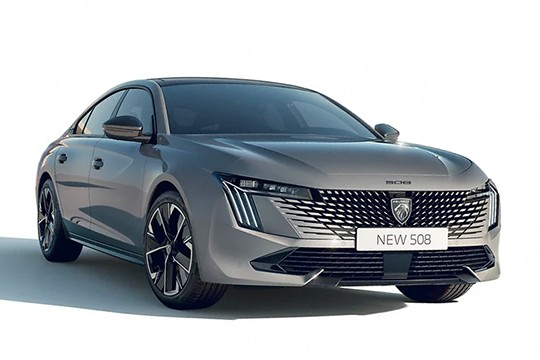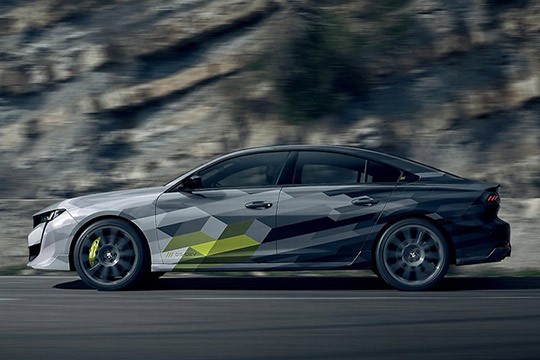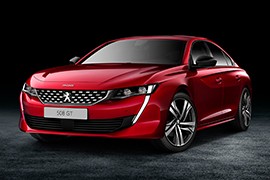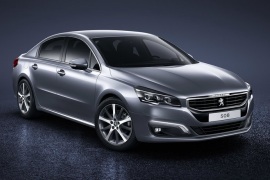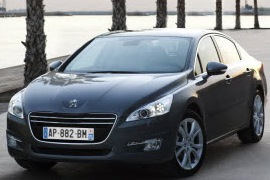PEUGEOT 508 Models/Series Timeline, Specifications & Photos
First production year: 2010
Engines: Gasoline, Diesel, Plug-in hybrid, Hybrid
Peugeot refreshed the second generation of its flagship model, the 508, after five years on the market to boost the car's sales.
The French automaker was part of the Stellantis family. It introduced the second generation of the 508 in February 2018. Come 2023, the automaker brought the facelifted version of this lineup. The car was not just another mid-size sedan on the European market; it was a statement that Peugeot targeted higher-profile clients.
At the front, the automaker installed a redesigned front grille with a 3D pattern flanked by two LED vertical lines for DRLs. The 508's slim headlights were available with Matrix-LED technology. The car's four-door coupe shape remained unchanged. Finally, at the back, the rear fascia was updated with redesigned taillights that sported three "fangs" on them.
Inside, the automaker installed a wide 10" touchscreen for the infotainment system. The front high-bolstered bucket seats provided adequate side support for their occupants, while at the back, the bench was most suitable for two occupants. Thanks to the car's long wheelbase, there was enough legroom for those seated in the back, and the center tunnel was short enough to accommodate a third passenger in the middle for short jaunts.
Under the hood, Peugeot launched the vehicle with a choice of turbo-diesel, gasoline, and hybrid powerplants. Besides the six-speed manual versions, the automaker also offered an eight-speed automatic transmission.
Peugeot introduced the 508 PSE in July 2020, not as a facelift but more as a flagship sedan for the French brand. It offered racing technologies for street applications.
Peugeot is one of the oldest brands in the motoring industry. Even if it started with coffee mills and bicycles, the French brand made its way into the world, and its name was tightened with victories on various races such as the LeMans, Paris-Dakar, Pike's Peak or the World Rally Championship.
The 508 PSE featured a new front fascia, with an LED strip for the daytime running lights that crossed the headlight onto the front bumper. The Kryptonite color (a special gray) was offered exclusively on the PSE range. They used the same color for the three-claws badges on the back and the car's side. The coupe-like shape of the 508 sedan was acclaimed for its beauty and its frameless windows.
Inside, the French specialist put the three-claw badge on the bottom of the steering wheel, but in green-lime accents. Another line with the same color crossed the dashboard. The Peugeot i-Cockpit graphic animations and the central 10-inch HD capacitive touchscreen have adopted the division's signature for an even more upscale feel.
The powertrain was a significant development. It featured a plug-in hybrid drivetrain that offered 360 hp. The battery pack could recharge in less than two hours from a 7kW wall-box socket or seven hours from a standard home outlet. It featured a 42 km (26 miles) range on EV mode. On top of that, the 508 PSE was all-wheel-drive. The gasoline engine powered the front wheels while the electric motor sent its power to the rear axle.
If someone would have asked me years ago if Peugeot could ever make such a beautiful car, I would’ve said no. Surprisingly, over the past few years, Peugeot raised the bar with exceptional designs and great features.
The Peugeot 508 had an impressive design. While it looked like a 5-door sedan, a closer look would make you understand that it was more a proper 5-door coupe due to the frameless doors and the lowered roofline.
In the front, what seemed like an innovation was the hood lid made of ABS. Its purpose was clear with regards to the pedestrians, however, the way Peugeot integrated it into the bumper was beautiful. The headlamps of the 508 looked like real jewelries. What was more, the 508 logo was placed on the front bumper, like never before.
The roof was also unusual, having a concave structure.
Once you opened the door of the 2018 508, the beautiful interior would hit you instantly. Soft materials, perforated suede, flawless stitches, bottom cut steering wheel, cupholders, armrest, nice leather. Of course, we are talking about the top of the range.
Both legroom and headroom was satisfying for the rear passengers, while it might not have looked so from the outside. The 508 looks smaller on the outside and properly optimised on the inside.
The 508 was equipped with adaptive cruise control, lane departure assist and lane assist.
One of the Peugeot’s best selling family sedan in France, the 508 was restyled in 2014.
The biggest changes in 2014 included modernised equipment, a new Diesel engine and an automatic gearbox that was not available for the previous model.
The interior design wasn’t changed very much, as the classical look was well appreciated in the past. However, practicality was improved. The GPS that was placed on the center console was moved with the new touchscreen interface borrowed from the Peugeot 308.
New equipments included blind spot alert, a rear-view camera that was standard on the Feline and the GT trim level and a full-LED options.
As before, the 5088 offered generous space for the passengers in the rear seats, as well as a good size trunk of 515 L.
The most important change was represented by the 2.0-liter engine that developed 150 hp or 180 hp. The 180 hp version could be mated with the new 6-speed automatic gearbox.
The top of the range was the 2.2-liter HDi engine with 204 hp, a more powerful and refined powerplant.
The Peugeot 508 was not a cheap car, and with the new looks, Peugeot raised the prices as well.
The range started at around $23.000 and could go up to around $40.000 for the most equipped 508 with the GT trim levels.
Peugeot introduced the 508 lineup in 2010 during the world financial crisis, trying to survive to stay afloat in a market where other famous automakers had major difficulties, and the French automaker’s efforts paid off.
Peugeot tried to cut expenses and production costs and introduced the 508 as a replacement for two vehicles: the mid-size sedan 407 and the executive D-segment sedan, the 607. The solution worked well, and while those who were eager to get a new generation of the 407 were satisfied since they received a larger car, those who asked for a better 607 got what they were asking for. The 508 was one of the vehicles that helped the French brand survive in the grueling market of the world financial crisis. Its features were good enough for those looking for a premium sedan, but its price was closer to mass-market vehicles.
At the front, the carmaker’s design team created many details that made the car look different in a market dominated by bland, uninspired mass-market vehicles of a similar size. Its broad trapezoidal grille was included in the bumper. It was flanked by organic-shaped swept-back headlights, which were continued on the fenders by the creases that formed the vehicle’s waistline. Lower, on the apron, Peugeot installed a second air intake that helped with the cooling, which was flanked by the fog lamps. Another unique design was for the hood, where the brand’s logo was applied into a recessed section extended towards the windshield.
From its profile, the car featured an arched waistline that went upward up to the B-pillars and then was slightly sloped down towards the back of the car. The greenhouse was also shaped like a curved line, and the B-post was black to create the image of a fake coupe. One of the brand’s particular design elements was the small triangular window placed on the forward area of the front doors and the rearview mirrors next to them. At the back, the automaker installed broad taillights extended from the quarter panels to the rear fascia but without being stretched over the trunk’s lid.
Inside, there was a sense of luxury and premium feel offered by many soft-touch areas on the dashboard, door cards, and the center console. The front bucket seats were designed for comfort, and the driver fronted a binocular-style instrument cluster where the speedometer and tachometer flanked an LCD between. Furthermore, Peugeot offered a head-up display, which was unusual for a mass-market vehicle. Still, information was not projected onto the windshield but on a separate retractable glass panel mounted above the instrument cluster’s visor. In the back, thanks to the long wheelbase and the low center tunnel that crossed the car from front to back, there was enough room for three passengers.
Under the hood, Peugeot installed a choice of turbo diesel and gasoline engines made mostly for fuel efficiency. In addition, the automaker offered a hybrid system powered by a small turbo-diesel powerplant and an electric motor. It didn’t have a long electric range but was good enough for silently parking the vehicle. This version was also the only 508 that featured an all-wheel drive system.
